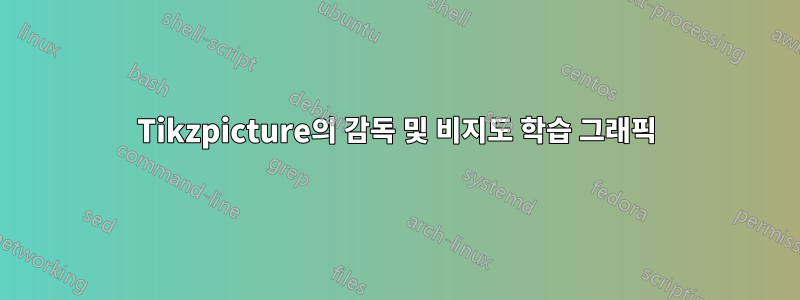
를 사용하여 이 두 플롯을 표현하고 싶습니다 tikzpicture. 아래와 같이 결합할 필요는 없지만 비슷한 것을 갖고 싶습니다.
아래와 같이 산점도를 생성할 수 있습니다.
두 개의 고유하고 구별되는 클러스터가 있습니다. 지도 학습 예시에서와 같이 선형으로 분리 가능한 선을 그리는 동시에 비지도 학습 예시에서도 클러스터를 그리고 싶습니다.
또한 색상/더 큰 포인트를 갖는 것이 좋습니다.
암호:
\documentclass{article}
\usepackage{pgfplots}
\begin{document}
\begin{tikzpicture}
\begin{axis}[%
axis lines = left,
xlabel = x,
ylabel = y,
]
\addplot[only marks] table [%
x = x,
y = y,
col sep = comma]{
x, y
%cluster 1
2, 3
3, 5
4, 5
3, 8
5, 9
3, 2
5, 6
6, 6
7, 9
10, 4
11, 5
9, 4
%cluser 2
20, 10
21, 12
24, 12
25, 13
27, 14
22, 13
23, 15
25, 10
15, 14
};
\end{axis}
\end{tikzpicture}
\end{document}
답변1
두 클러스터의 포인트 형식을 다르게 지정할 수 있지만 scatter/classes두 클러스터로 분할하는 것이 더 쉽습니다 \addplot. 형식을 설정하려면 eg 를 사용하세요 \addplot [blue, only marks, mark=*, mark size=5] .... 대부분 설명이 필요합니다.
선과 원의 경우 거의 일반적인 TikZ 명령을 사용하는 경우입니다. 기본적으로 환경 \draw (x,y) ..내부에서 수행하고 의 좌표계에 있지 않은 경우 참고 하세요 .axisxyaxis하지 않는 한a) 을 사용 (axis cs:x,y)하거나 b) 추가 \pgfplotsset{compat=1.11}(또는 더 높은 버전 번호) 중 하나를 선택하세요. 이 경우 axis cs기본값이 됩니다.
내부에는 circle[radius=2]( 제 생각에는) axis필요 compat=1.11하지만 반경은 다시 축 좌표에 있으므로 이 경우 타원이 됩니다. 대신에 할 수 있는 일은 내부에 좌표를 정의 axis하고 외부에 원을 그리는 것입니다. 두 가지 모두 아래 코드에 설명되어 있습니다.
\documentclass{article}
\usepackage{pgfplots}
\pgfplotsset{compat=1.11} % <-- added
\begin{document}
\begin{tikzpicture}
\begin{axis}[%
axis lines = left,
xlabel = $x$,
ylabel = $y$,
clip mode=individual % so things drawn by \draw and similar are not cut off
]
\addplot [blue, only marks, mark=*, mark size=5] table [%
x = x,
y = y,
col sep = comma]{
x, y
%cluster 1
2, 3
3, 5
4, 5
3, 8
5, 9
3, 2
5, 6
6, 6
7, 9
10, 4
11, 5
9, 4
};
\addplot+[red, only marks, mark=*, mark size=5] table [%
x = x,
y = y,
col sep = comma]{
x, y
20, 10
21, 12
24, 12
25, 13
27, 14
22, 13
23, 15
25, 10
15, 14
};
% to be able to use axis coordinates with \draw directly you need
% \pgfplotsset{compat=1.11} or a higher version
% if that is not present, use (axis cs:4,14) instead of (4,14),
% to specify that the values should be interpreted as axis coordinates
\draw [dashed] (4,14) -- (25,2);
% save a coordinate for use later
\coordinate (c2) at (23,12);
% the blue circle is drawn inside the axis environment, and in axis coordinates
% hence it becomes an ellipse
\draw [blue, dashed] (6,6) circle[radius=5];
\end{axis}
% the red circle is drawn outside the axis, so actually looks like a circle,
% but the radius has no relation to the axis coordinates
\draw [red, dashed] (c2) circle[radius=2cm];
\end{tikzpicture}
\end{document}
두 개의 축
두 개의 플롯을 나란히 배치하는 방법에는 여러 가지가 있습니다. 두 개의 tikzpictures를 차례로 추가하거나 axis동일한 환경에 두 개의 환경을 두고 tikzpicture두 번째 환경을 \begin{axis}[at={(x,y)},.... 개인적으로 저는 축 그리드를 만드는 라이브러리 groupplot의 환경을 좋아합니다.groupplots
\documentclass{article}
\usepackage{pgfplots}
\usepgfplotslibrary{groupplots}
\pgfplotsset{compat=1.11}
\begin{document}
\begin{tikzpicture}
\begin{groupplot}[
group style={
group size=2 by 1,
horizontal sep=1.5cm
},
axis lines = left,
xlabel = $x$,
ylabel = $y$,
width=5cm, % <-- set size of axes
clip mode=individual, % to avoid \draws being cut off
title style={yshift=1mm, font=\bfseries\sffamily}
]
\nextgroupplot[title=Supervised learning]
\addplot [blue, only marks, mark=*, mark size=3] table [%
x = x,
y = y,
col sep = comma]{
x, y
%cluster 1
2, 3
3, 5
4, 5
3, 8
5, 9
3, 2
5, 6
6, 6
7, 9
10, 4
11, 5
9, 4
};
\addplot+[red, only marks, mark=*, mark size=3] table [%
x = x,
y = y,
col sep = comma]{
x, y
20, 10
21, 12
24, 12
25, 13
27, 14
22, 13
23, 15
25, 10
15, 14
};
% to be able to use axis coordinates with \draw directly you need
% \pgfplotsset{compat=1.11} or a higher version
% if that is not present, use (axis cs:4,14) instead of (4,14),
% to specify that the values should be interpreted as axis coordinates
\draw [dashed] (4,14) -- (25,2);
\nextgroupplot[title=Unsupervised learning]
\addplot [blue, only marks, mark=*, mark size=3] table [%
x = x,
y = y,
col sep = comma]{
x, y
%cluster 1
2, 3
3, 5
4, 5
3, 8
5, 9
3, 2
5, 6
6, 6
7, 9
10, 4
11, 5
9, 4
};
\addplot+[red, only marks, mark=*, mark size=3] table [%
x = x,
y = y,
col sep = comma]{
x, y
20, 10
21, 12
24, 12
25, 13
27, 14
22, 13
23, 15
25, 10
15, 14
};
% save a coordinate for use later
\coordinate (c2) at (23,12);
% the blue circle is drawn inside the axis environment, and in axis coordinates
% hence it becomes an ellipse
\draw [blue, dashed] (6,6) circle[radius=5];
\end{groupplot}
% the red circle is drawn outside the axis, so actually looks like a circle,
% but the radius has no relation to the axis coordinates
\draw [red, dashed] (c2) circle[radius=1cm];
\end{tikzpicture}
\end{document}






